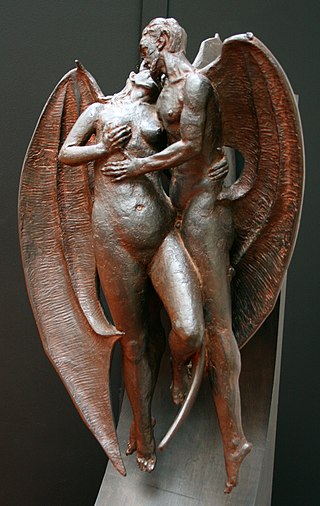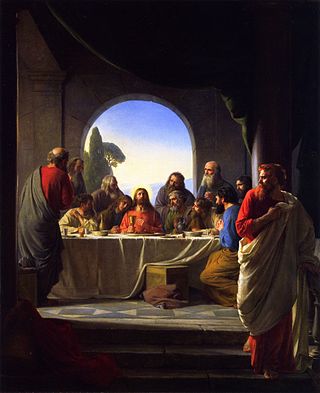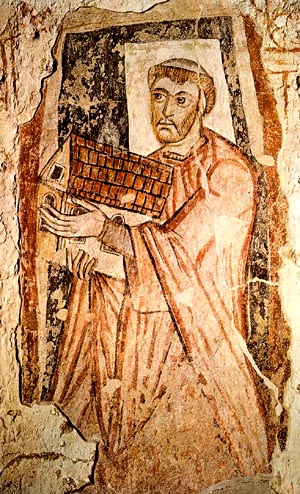The Book of Malachi is the last book of the Neviim contained in the Tanakh, canonically the last of the Twelve Minor Prophets. In most Christian orderings, the grouping of the prophetic books is the last section of the Old Testament, making Malachi the last book before the New Testament.

A devil is the personification of evil as it is conceived in various cultures and religious traditions. It is seen as the objectification of a hostile and destructive force. Jeffrey Burton Russell states that the different conceptions of the devil can be summed up as 1) a principle of evil independent from God, 2) an aspect of God, 3) a created being turning evil, and 4) a symbol of human evil.

In folklore, a ghost is the soul or spirit of a dead person or non-human animal that is believed to be able to appear to the living. In ghostlore, descriptions of ghosts vary widely, from an invisible presence to translucent or barely visible wispy shapes to realistic, lifelike forms. The deliberate attempt to contact the spirit of a deceased person is known as necromancy, or in spiritism as a séance. Other terms associated with it are apparition, haunt, haint, phantom, poltergeist, shade, specter, spirit, spook, wraith, demon, and ghoul.

The Vulgate, sometimes referred to as the Latin Vulgate, is a late-4th-century Latin translation of the Bible.

Judas Iscariot was—according to Christianity's four canonical gospels—a disciple and one of the original Twelve Apostles of Jesus Christ. Judas betrayed Jesus to the Sanhedrin in the Garden of Gethsemane by kissing him on the cheek and addressing him as "master" to reveal his identity in the darkness to the crowd who had come to arrest him. Like Brutus, his name is often used synonymously with betrayal or treason.

Benedict Biscop, also known as Biscop Baducing, was an Anglo-Saxon abbot and founder of Monkwearmouth-Jarrow Priory and was considered a saint after his death.

The Codex Argenteus is a 6th-century illuminated manuscript, originally containing part of the 4th-century translation of the Christian Bible into the Gothic language. Traditionally ascribed to the Arian bishop Wulfila, it is now established that the Gothic translation was performed by several scholars, possibly under Wulfila's supervision. Of the original 336 folios, 188—including the Speyer fragment discovered in 1970—have been preserved, containing the translation of the greater part of the four canonical gospels. A part of it is on permanent display at the Carolina Rediviva building in Uppsala, Sweden, under the name "Silverbibeln".

Michael, also called Saint Michael the Archangel, Archangel Michael and Saint Michael the Taxiarch is an archangel in Judaism, Christianity, Islam, and the Baha'i faith. The earliest surviving mentions of his name are in 3rd and 2nd-century BC Jewish works, often but not always apocalyptic, where he is the chief of the angels and archangels, and he is the guardian prince of Israel and is responsible for the care of Israel. Christianity adopted nearly all the Jewish traditions concerning him, and he is mentioned explicitly in Revelation 12:7–12, where he does battle with Satan, and in the Epistle of Jude, where the author denounces heretics by contrasting them with Michael.

Saint Ceolfrid was an Anglo-Saxon Christian abbot and saint. He is best known as the warden of Bede from the age of seven until his death in 716. He was the Abbot of Monkwearmouth-Jarrow Abbey, and a major contributor to the project to produce the Codex Amiatinus Bible. He died in Burgundy while en route to deliver a copy of the codex to Pope Gregory II in Rome.

The Codex Gigas is the largest extant medieval illuminated manuscript in the world, at a length of 92 cm (36 in). Very large illuminated bibles were typical of Romanesque monastic book production, but even among these, the page-size of the Codex Gigas is exceptional. The manuscript is also known as the Devil's Bible due to its highly unusual full-page portrait of Satan, and the legend surrounding the book's creation.

George Basil Haliburton Hume was an English Catholic bishop. He was a monk and priest of the English Benedictine monastery of Ampleforth Abbey and its abbot for 13 years until his appointment as Archbishop of Westminster in 1976. His elevation to a cardinal followed during the same year. From 1979, Hume served also as president of the Catholic Bishops' Conference of England and Wales. He held these appointments until his death from cancer in 1999. His final resting place is at Westminster Cathedral in the Chapel of St Gregory and St Augustine.

Matthew 4:1 is the first verse of the fourth chapter of the Gospel of Matthew in the New Testament. This verse opens the section in Matthew dealing with the temptation of Christ by Satan. Jesus has just been baptized by John the Baptist; in this verse he is led out into the wilderness.

A deal with the Devil is a cultural motif exemplified by the legend of Faust and the figure of Mephistopheles, as well as being elemental to many Christian traditions. According to traditional Christian belief about witchcraft, the pact is between a person and the Devil or another demon, trading a soul for diabolical favours, which vary by the tale, but tend to include youth, knowledge, wealth, fame and power.

Chrast is a town in Chrudim District in the Pardubice Region of the Czech Republic. It has about 3,200 inhabitants. The historic centre with the castle complex is well preserved and is protected by law as an urban monument zone.

Kremsmünster Abbey is a Benedictine monastery in Kremsmünster in Upper Austria.
Discernment of spirits is a term used in Eastern Orthodox, Roman Catholic and Charismatic (Evangelist) Christian theology to judge the influence of various spiritual agents on a person's morality. These agents are:
- from within the human soul itself, known as concupiscence
- Divine Grace
- Angels
- Devils
In the Bible, the word "flesh" is often used simply as a description of the fleshy parts of an animal, including that of human beings, and typically in reference to dietary laws and sacrifice. Less often it is used as a metaphor for familial or kinship relations, and as a metaphor to describe sinful tendencies. A related turn of phrase identifies certain sins as "carnal" sins, from Latin caro, carnis, meaning "flesh."

Esrum Abbey, also Esrom Abbey, was the second Cistercian monastery founded in Denmark, located near Hillerød in Region Hovedstaden, on the island of Zealand (Sjælland), on the north side of the Esrum Sø near Esbønderup and Græsted.

Revelation 20 is the twentieth chapter of the Book of Revelation or the Apocalypse of John in the New Testament of the Christian Bible. The book is traditionally attributed to John the Apostle, but the precise identity of the author remains a point of academic debate. This chapter contains the notable account of the "Millennium" and the judgment of the dead.















